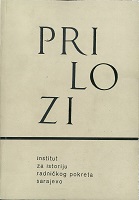POLITIČKE MJERE OKUPATORA I USTAŠA PROTIV USTANKA I NARODNOOSLOBODILAČKOG POKRETA U BOSNI HERCEGOVINI U PRVOJ POLOVINI 1942. GODINE
THE POLITICAL MEASURES OF THE OCCUPIERS AND THE USTASA AGAINST THE UPRISING AND PEOPLE'S LIBERATION MOVEMENT IN BOSNIA AND HERCEGOVINA IN THE FIRST HALF OF 1942
Author(s): Rasim HuremSubject(s): Political behavior, Politics and society, Crowd Psychology: Mass phenomena and political interactions, WW II and following years (1940 - 1949)
Published by: Institut za istoriju
Keywords: People's Liberation Movement; 1942; political measures;
Summary/Abstract: The German occupation forces in Yugoslavia began to take a direct interest in the events .in Bosnia and Hercegovina only after it had successfully concluded military operations against the Partizan forces in western Serbia in November of 1941. In the meantime, the uprising in Bosnia and Hercegovina was flourishing, so that Bosnia became the area of its direct operative .interests and activity. At the same time, the process of political differentiation of the forces in the uprising developed. In this regard, the occupation forces, and under their pressure the Ustasa regime of the Independent State of Croatia, decided in favor of an attempt to split the uprising forces and, by means of various steps, to win over the »national« uprising element and thus more easily overcome the »Communist« element. The Commando Supremo and the OKW, in preparing military operations against insurgents in Bosnia and Hercegovina accepted negotiations with the Cetniks as a useful thing. The Ustasa regime, for its part, had begun to change its position towards Serbs in the Independent State of Croatia (ISC) and to take a more moderate stand towards them. This turn in the policy of the Ustasa leadership is illustrated by the convention of the Croatian State Assembly, the founding of the so-called Croatian Orthodox Church and the conclusion of an agreement with the Cetnik leaders stipulating a division of power in the appropriate areas of the ISC and joint action against the People's Liberation Movement. The author gives an exhaustive analysis of these measures whose effectiveness was aided by the fact that the insurgents and the people who supported them were becoming fatigued from the battle and satiated with the war, as well as the fact that the German and Italian occupying forces and Ustasa troops, with the assistance of the Cetniks, were conducting at that time a considerable military operation against the Bosnian and Hercegovinian partizans. In conclusion the author points out that the measures undertaken by the occupiers and Ustasa forces, especially the agreement with the Cetniks in Bosnia, i. e. the recognition on the part of the ISC of their status which came about as a result of earlier arrangements with the Italian military powers of eastern Hercegovina, acted in the direction of pacifying the rebellious peoples. The Serbian population began to accommodate itself to the situation in which it was not exposed to the physical annihilation it had faced earlier (in the first months of the existence of the ISC). A large number of Serbs who had participated in the rebellion found it wiser in the new conditions to occupy themselves with their own business rather than to continue to struggle and sustain the losses. The relationship of the forces in eastern and central Bosnia and eastern Hercegovina changed unfavorably for the People's Liberation Movement. Concurrently the positions of the ISC and of the Cetniks were strengthened in these areas.
Journal: Prilozi
- Issue Year: 1970
- Issue No: 6
- Page Range: 125-147
- Page Count: 23
- Language: Bosnian

